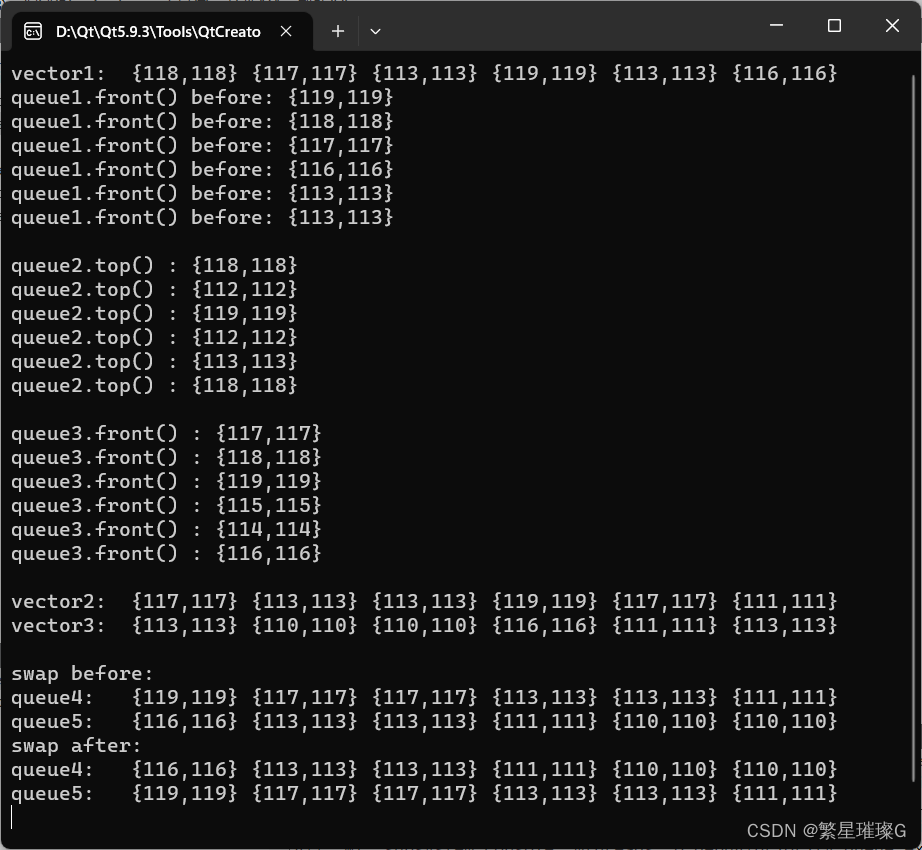适配一个容器以提供优先级队列
std::priority_queue定义于头文件 <queue>
| template< class T, |
priority_queue 是容器适配器,它提供常数时间的(默认)最大元素查找,对数代价的插入与释出。
可用用户提供的 Compare 更改顺序,例如,用 std::greater<T> 将导致最小元素作为 top() 出现。
用 priority_queue 工作类似管理某些随机访问容器中的堆,优势是不可能突然把堆非法化。
模板形参
| T | - | 存储的元素类型。若 T 与 Container::value_type 不是同一类型则行为未定义。 (C++17 起) |
| Container | - | 用于存储元素的底层容器类型。容器必须满足序列容器 (SequenceContainer) 的要求,而其迭代器必须满足遗留随机访问迭代器 (LegacyRandomAccessIterator) 的要求。另外,它必须提供拥有通常语义的下列函数:
标准容器 std::vector 和 std::deque 满足这些要求。 |
| Compare | - | 提供严格弱序的比较 (Compare) 类型。 |
注意 比较 (Compare) 形参的定义,使得若其第一参数在弱序中先于其第二参数则返回 true 。但因为 priority_queue 首先输出最大元素,故“先来”的元素实际上最后输出。即队列头含有按照 比较 (Compare) 所施加弱序的“最后”元素。
元素访问
访问栈顶元素
std::priority_queue<T,Container,Compare>::top| const_reference top() const; |
返回到 priority_queue 顶元素的引用。此元素将在调用 pop() 时被移除。若使用默认比较函数,则返回的元素亦为优先队列中最大的元素。
参数
(无)
返回值
到顶元素的引用,如同以调用 c.front() 获得。
复杂度
常数。
修改器
插入元素,并对底层容器排序
std::priority_queue<T,Container,Compare>::push| void push( const value_type& value ); |
||
| void push( value_type&& value ); |
(C++11 起) |
推给定的元素 value 到 priority_queue 中。
1) 等效地调用 c.push_back(value); std::push_heap(c.begin(), c.end(), comp);
2) 等效地调用 c.push_back(std::move(value)); std::push_heap(c.begin(), c.end(), comp);
参数
| value | - | 要推入的元素值 |
返回值
(无)
复杂度
对数次比较加 Container::push_back 的复杂度。
删除栈顶元素
std::priority_queue<T,Container,Compare>::pop| void pop(); |
从 priority_queue 移除顶元素。等效地调用 std::pop_heap(c.begin(), c.end(), comp); c.pop_back(); 。
参数
(无)
返回值
(无)
复杂度
对数次比较加 Container::pop_back 的复杂度。
交换内容
std::priority_queue<T,Container,Compare>::swap| void swap( priority_queue& other ) noexcept(/* see below */); |
(C++11 起) |
交换容器适配器与 other 的内容。等效地调用 using std::swap; swap(c, other.c); swap(comp, other.comp); 。
参数
| other | - | 要交换内容的容器适配器 |
返回值
(无)
示例
| noexcept 规定: noexcept(noexcept(swap(c, other.c)) && noexcept(swap(comp, other.comp))) 上述表达式中,用与 C++17 std::is_nothrow_swappable 特性所用的相同方式查找标识符 |
(C++17 前) |
| noexcept 规定: noexcept(std::is_nothrow_swappable<Container>::value && std::is_nothrow_swappable<Compare>::value) |
(C++17 起) |
复杂度
与底层容器相同(典型地为常数)。
调用示例
#include <iostream>
#include <forward_list>
#include <string>
#include <iterator>
#include <algorithm>
#include <functional>
#include <queue>
#include <deque>
#include <time.h>
using namespace std;
struct Cell
{
int x;
int y;
Cell() = default;
Cell(int a, int b): x(a), y(b) {}
Cell &operator +=(const Cell &cell)
{
x += cell.x;
y += cell.y;
return *this;
}
Cell &operator +(const Cell &cell)
{
x += cell.x;
y += cell.y;
return *this;
}
Cell &operator *(const Cell &cell)
{
x *= cell.x;
y *= cell.y;
return *this;
}
Cell &operator ++()
{
x += 1;
y += 1;
return *this;
}
bool operator <(const Cell &cell) const
{
if (x == cell.x)
{
return y < cell.y;
}
else
{
return x < cell.x;
}
}
bool operator >(const Cell &cell) const
{
if (x == cell.x)
{
return y > cell.y;
}
else
{
return x > cell.x;
}
}
bool operator ==(const Cell &cell) const
{
return x == cell.x && y == cell.y;
}
};
std::ostream &operator<<(std::ostream &os, const Cell &cell)
{
os << "{" << cell.x << "," << cell.y << "}";
return os;
}
template<typename _Tp, typename _Sequence = vector<_Tp>,
typename _Compare = less<typename _Sequence::value_type> >
void queuePrint(const std::string &name,
const std::priority_queue<_Tp, vector<_Tp>, _Compare> &queue)
{
std::cout << name ;
std::priority_queue<_Tp, vector<_Tp>, _Compare> queuep = queue;
while (queuep.size() > 0)
{
std::cout << queuep.top() << " ";
queuep.pop();
}
std::cout << std::endl;
}
struct Compare
{
Compare() {}
bool operator()(const Cell &a, const Cell &b)const
{
if (a.x == b.x)
{
return a.y < b.y;
}
return a.x < b.x;
}
};
int main()
{
std::cout << std::boolalpha;
std::mt19937 g{std::random_device{}()};
srand((unsigned)time(NULL));
auto generate = []()
{
int n = std::rand() % 10 + 110;
Cell cell{n, n};
return cell;
};
std::vector<Cell> vector1(6);
std::generate(vector1.begin(), vector1.end(), generate);
std::cout << "vector1: ";
std::copy(vector1.begin(), vector1.end(), std::ostream_iterator<Cell>(std::cout, " "));
std::cout << std::endl;
//2) 以 cont 的内容复制构造底层容器 c 。
std::priority_queue<Cell> queue1(std::less<Cell>(), vector1);
while (!queue1.empty())
{
//返回到 priority_queue 顶元素的引用。
//此元素将在调用 pop() 时被移除。
//若使用默认比较函数,则返回的元素亦为优先队列中最大的元素。
//const_reference
std::cout << "queue1.front() before: " << queue1.top() << " ";
//从 queue 移除顶元素。等效地调用 c.pop_back()
queue1.pop();
std::cout << std::endl;
}
std::cout << std::endl;
std::priority_queue<Cell> queue2;
int index = 0;
while (index < 6)
{
Cell cell = generate();
if (queue2.size() % 2 == 0)
{
//推给定的元素 value 到 queue 尾。
//1) 等效地调用 c.push_back(value)
queue2.push(cell);
}
else
{
//推给定的元素 value 到 queue 尾。
//2) 等效地调用 c.push_back(std::move(value)),移动语义
queue2.push(std::move(cell));
}
std::cout << "queue2.top() : " << queue2.top() ;
queue2.pop();
std::cout << std::endl;
index++;
}
std::cout << std::endl;
std::priority_queue<Cell> queue3;
index = 0;
while (index < 6)
{
int n = std::rand() % 10 + 110;
//推入新元素到 queue 结尾。原位构造元素,即不进行移动或复制操作。
//以与提供给函数者准确相同的参数调用元素的构造函数。
//等效地调用 c.emplace_back(std::forward<Args>(args)...);
queue3.emplace(n, n);
std::cout << "queue3.front() : " << queue3.top() ;
std::cout << std::endl;
queue3.pop();
index++;
}
std::cout << std::endl;
std::vector<Cell> vector2(6);
std::generate(vector2.begin(), vector2.end(), generate);
std::cout << "vector2: ";
std::copy(vector2.begin(), vector2.end(), std::ostream_iterator<Cell>(std::cout, " "));
std::cout << std::endl;
std::vector<Cell> vector3(6);
std::generate(vector3.begin(), vector3.end(), generate);
std::cout << "vector3: ";
std::copy(vector3.begin(), vector3.end(), std::ostream_iterator<Cell>(std::cout, " "));
std::cout << std::endl;
std::cout << std::endl;
std::priority_queue<Cell> queue4(std::less<Cell>(), vector2);
std::priority_queue<Cell> queue5(std::less<Cell>(), vector3);
std::cout << "swap before: " << std::endl;
queuePrint("queue4: ", queue4);
queuePrint("queue5: ", queue5);
//交换容器适配器与 other 的内容。
//等效地调用 using std::swap; swap(c, other.c);
queue4.swap(queue5);
std::cout << "swap after: " << std::endl;
queuePrint("queue4: ", queue4);
queuePrint("queue5: ", queue5);
return 0;
}输出
